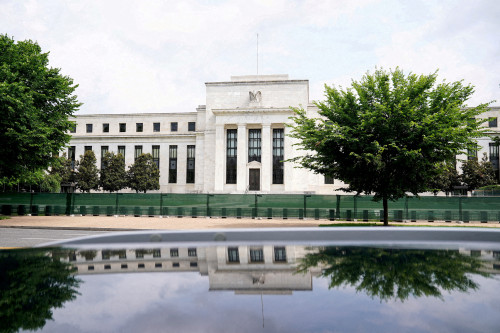By Lucia Mutikani
WASHINGTON (Reuters) – The U.S. trade deficit in goods narrowed in June for the first time this year amid a broad rebound in exports, but that probably was insufficient to prevent trade from remaining a drag on economic growth in the second quarter.
The impact on gross domestic product from the trade gap is, however, likely to be offset by a rise in inventories at wholesalers and retailers in June. The government is scheduled on Thursday to publish its advance estimate of second-quarter GDP growth, which is expected to show a pick-up in activity, thanks to a spurt in consumer spending in June.
“The hit to second-quarter GDP growth from net trade will probably be offset by inventories and investment,” said Oliver Allen, senior U.S. economist at Pantheon Macroeconomics.
The goods trade gap contracted 2.5% to $96.8 billion, the Commerce Department’s Census Bureau said on Wednesday. The goods trade deficit had widened since January.
Goods exports increased 2.5% to $172.3 billion, led by a 4.9% surge in shipments of food. Capital goods exports rose 3.6%. There was also a strong increase in exports of industrial supplies, which include crude oil.
Motor vehicles and parts exports rose, as did those of consumer and other goods. Exports have been hampered by slower global demand and a strong dollar as the Federal Reserve has kept interest rates elevated.
Imports of goods gained 0.7% to $269.2 billion. Consumer goods imports shot up 3.3%, likely reflecting solid domestic demand. Capital goods imports advanced 2.6%, which bodes well for business spending on equipment.
Imports of other goods rose 2.7%. But imports of industrial supplies, food and motor vehicles fell.
“Goods exports and imports both reversed their May declines in June,” said Carl Weinberg, chief economist at High Frequency Economics. “However, second-quarter imports were higher than the first-quarter average, while exports were weaker.”
Pantheon Macroeconomics estimated that trade subtracted as much as 1.4 percentage points from GDP growth last quarter, which would be the biggest drag in more than two years. Others, including Oxford Economics and Barclays, viewed the contraction in the goods trade gap in June as posing an upside risk to their second-quarter GDP estimates.
Some of the imports in June likely ended up in the warehouses of wholesalers and retailers. The report from the Census Bureau also showed wholesale inventories increased 0.2% in June after rising 0.6% in May. Retail inventories climbed 0.7%, boosted by a 1.8% gain in stocks at motor vehicles and parts dealers. Retail inventories advanced 0.6% in May.
Excluding motor vehicles and parts, retail inventories gained 0.2% in June after dipping 0.1% in May. This category goes into the calculation of GDP.
Business inventories are estimated to have added roughly 1.5 percentage points to GDP growth last quarter after subtracting from growth for two straight quarters.
INVENTORY BOOST
According to a Reuters survey of economists, GDP likely increased at a 2.0% annualized rate in the April-June quarter.
Both trade and inventory investment subtracted from GDP in the first quarter, with the economy growing at a 1.4% pace during that period.
Economists expect the trade gap to remain large, with businesses, wary of new tariffs on foreign goods, front-loading imports ahead of the Nov. 5 presidential election.
“The outlook for imports remains strong,” said Matthew Martin, a U.S. economist at Oxford Economics. “Consumer demand is resilient, and businesses are stocking up ahead of peak shipping season to refill depleted inventories, and perhaps in anticipation of increased tariffs following the elections.”
After providing a sizeable boost to the economy in the January-March quarter, the housing market’s fortunes have waned amid persistently higher mortgage rates and home prices.
A separate report from the Census Bureau on Wednesday showed new home sales slipped 0.6% to a seasonally adjusted annual rate of 617,000 units in June, the lowest level since November.
The second straight monthly decline extended the flow of weak housing data, including existing home sales, single-family housing starts and permits.
The housing market has been the sector hardest hit by the U.S. central bank’s aggressive monetary policy tightening.
It pulled out of its slump, with residential investment, which includes home building and sales, scoring double-digit growth in the first quarter. Economists believe that residential investment probably contracted in the April-June quarter.
The Fed has maintained its benchmark overnight interest rate in the current 5.25%-5.50% range for the past year. It has hiked its policy rate by 525 basis points since 2022 in its effort to tame high inflation.
The median new house price dipped 0.1% to $417,300 in June from a year ago as supply increased. The inventory of new homes rose in June to 476,000, the highest level since February 2008, from 472,000 units in May. At June’s sales pace it would take 9.3 months to clear the supply of houses on the market. That was the most since October 2022 and up from 9.1 months in May.
But with mortgage rates pulling back from the highs set in the spring on expectations of a rate cut in September, the outlook for the housing market is encouraging, at least for new construction.
“If, as we expect, this most recent downward trend in mortgage rates persists, however, then we think new home sales will be able to recover in the second half of the year,” said Thomas Ryan, North America economist at Capital Economics. “Even though home listings are slowly creeping up, the supply of previously owned homes remains historically tight.”
(Reporting by Lucia Mutikani; Editing by Andrew Heavens, Andrea Ricci and Paul Simao)



